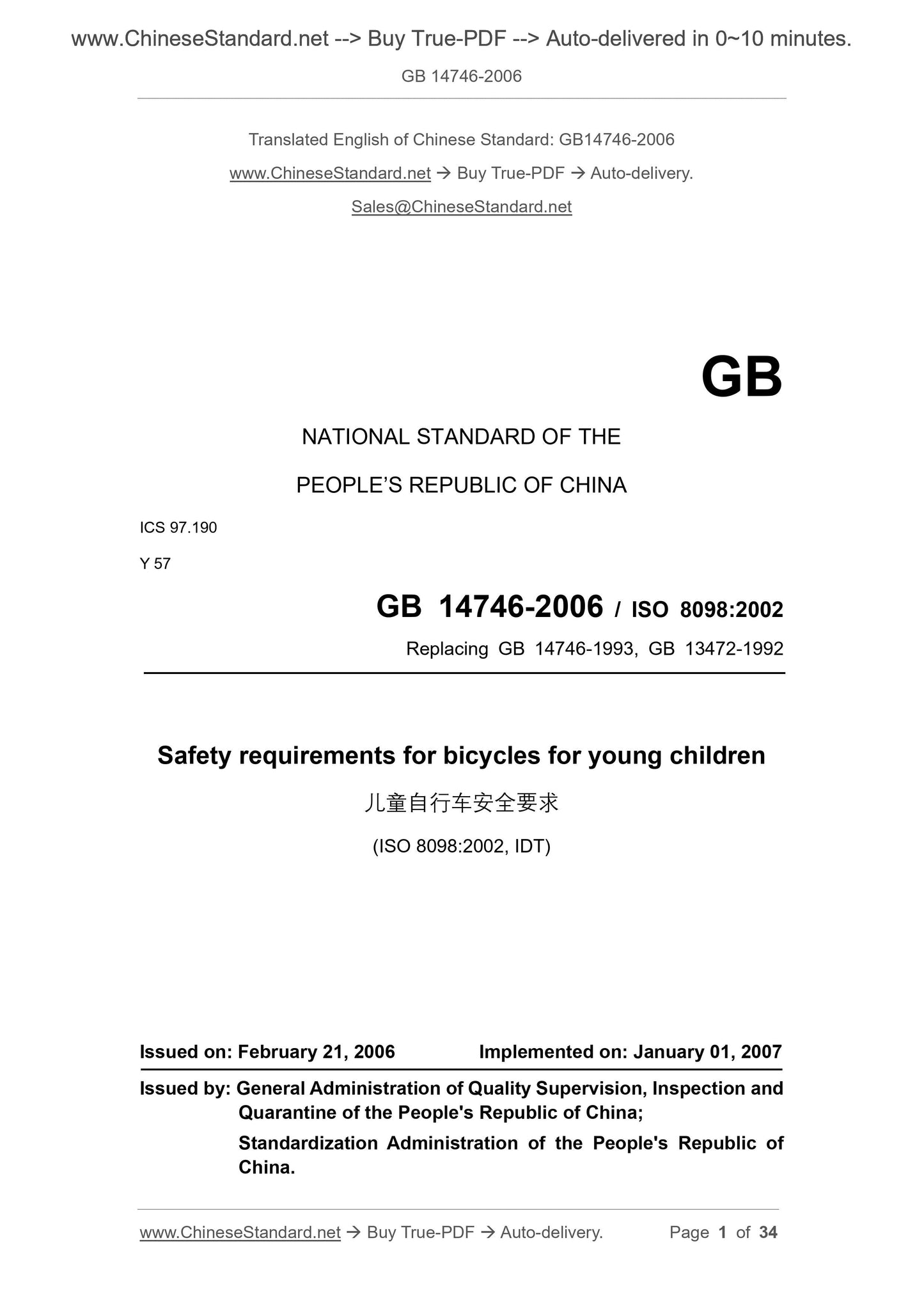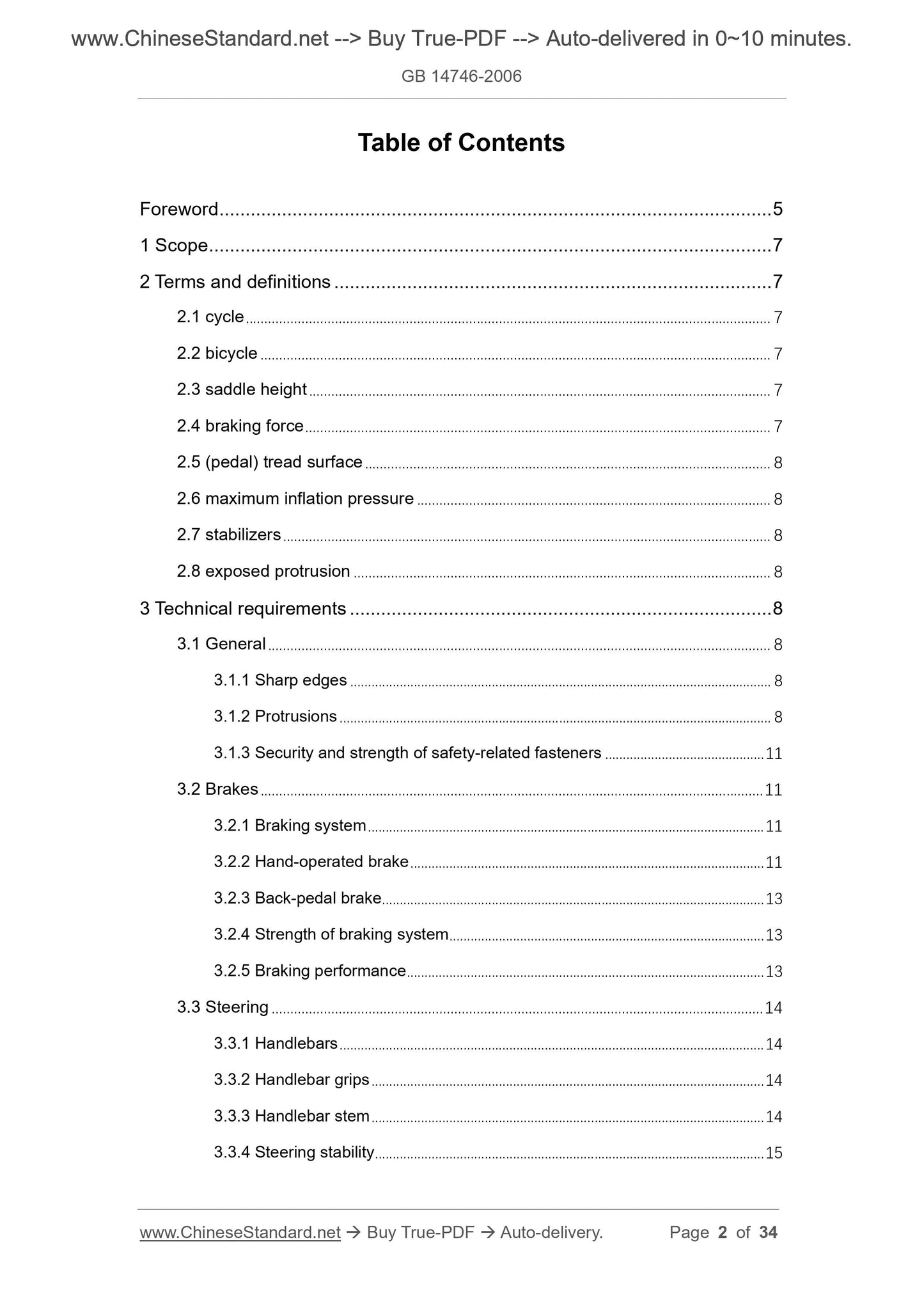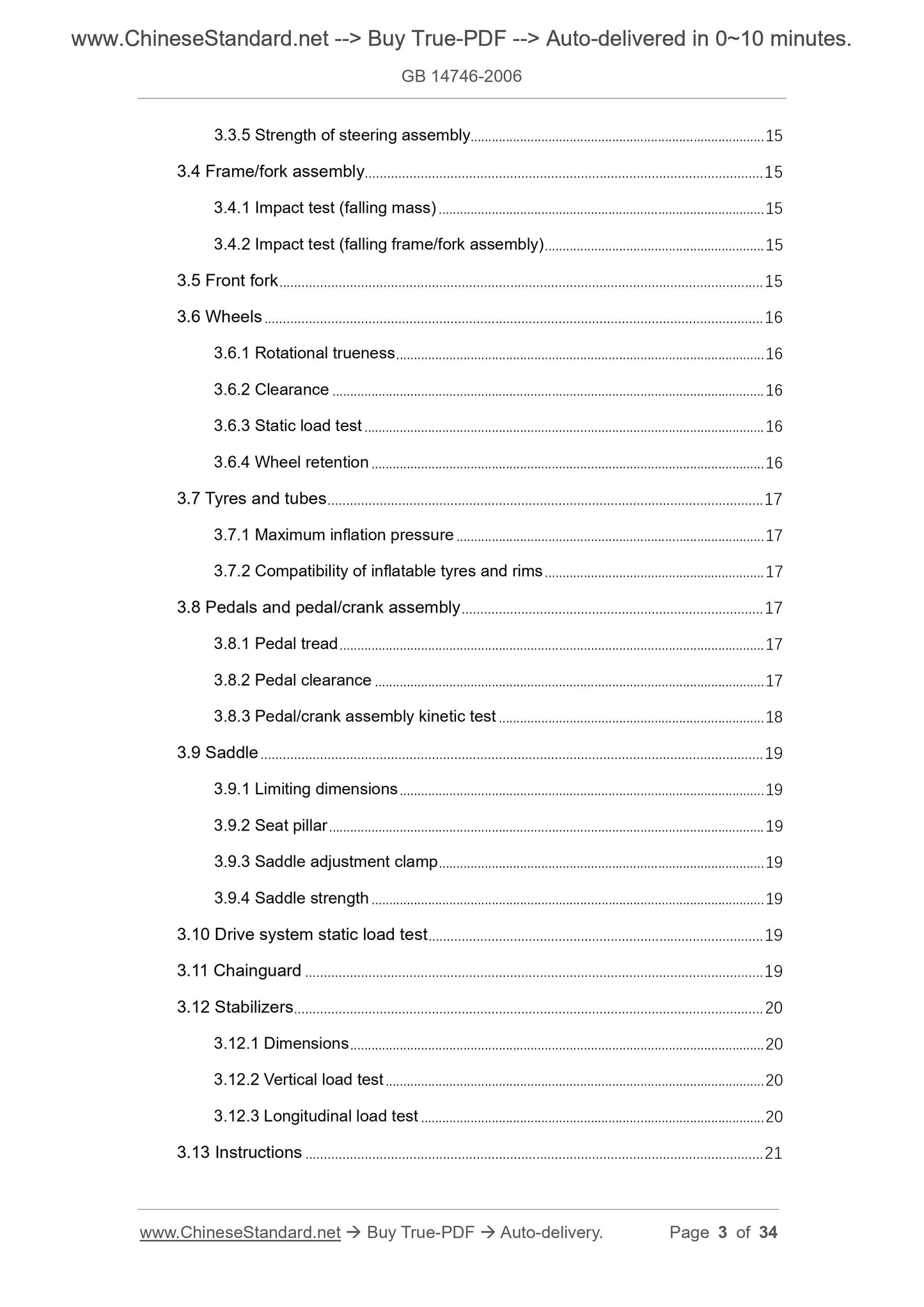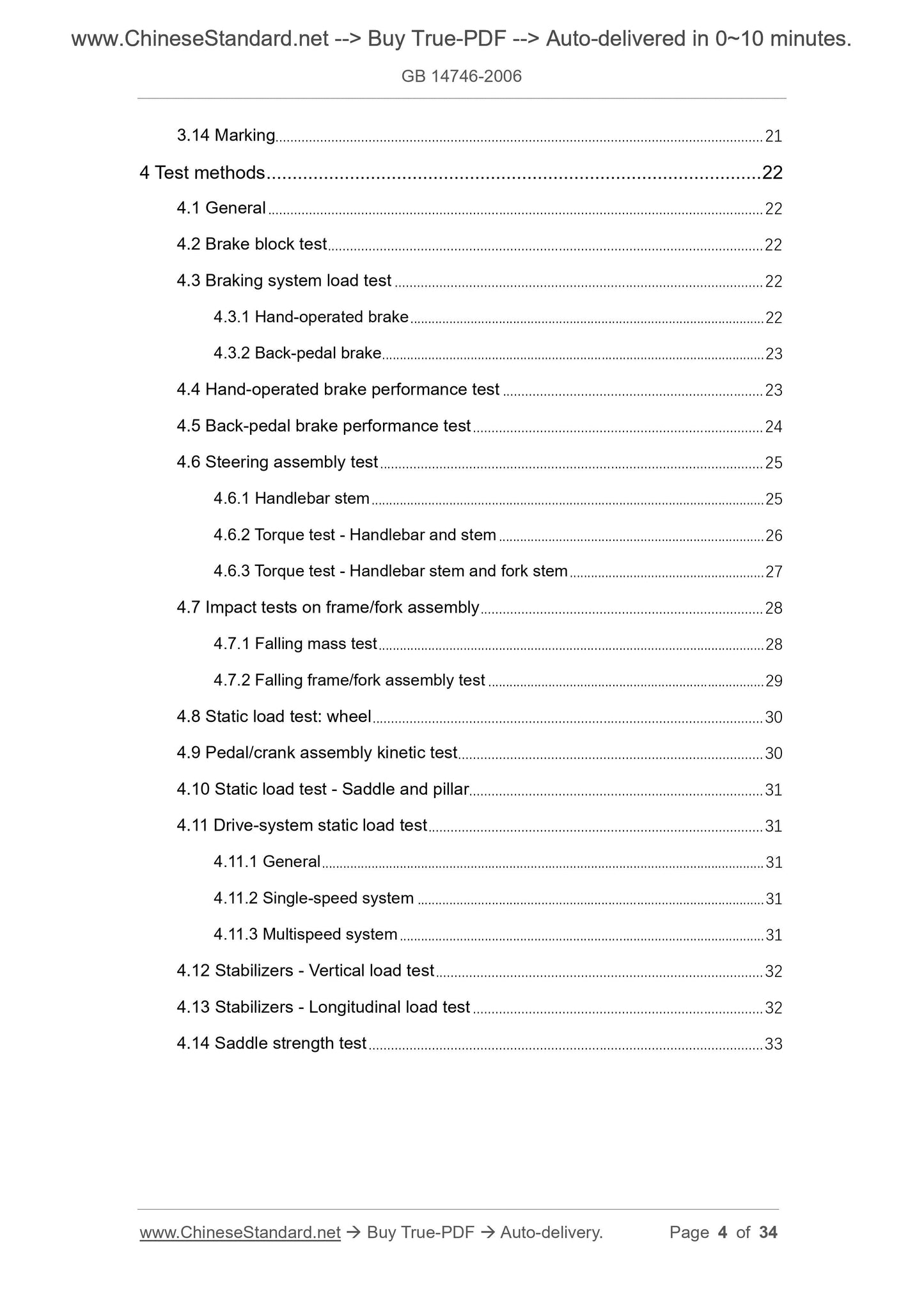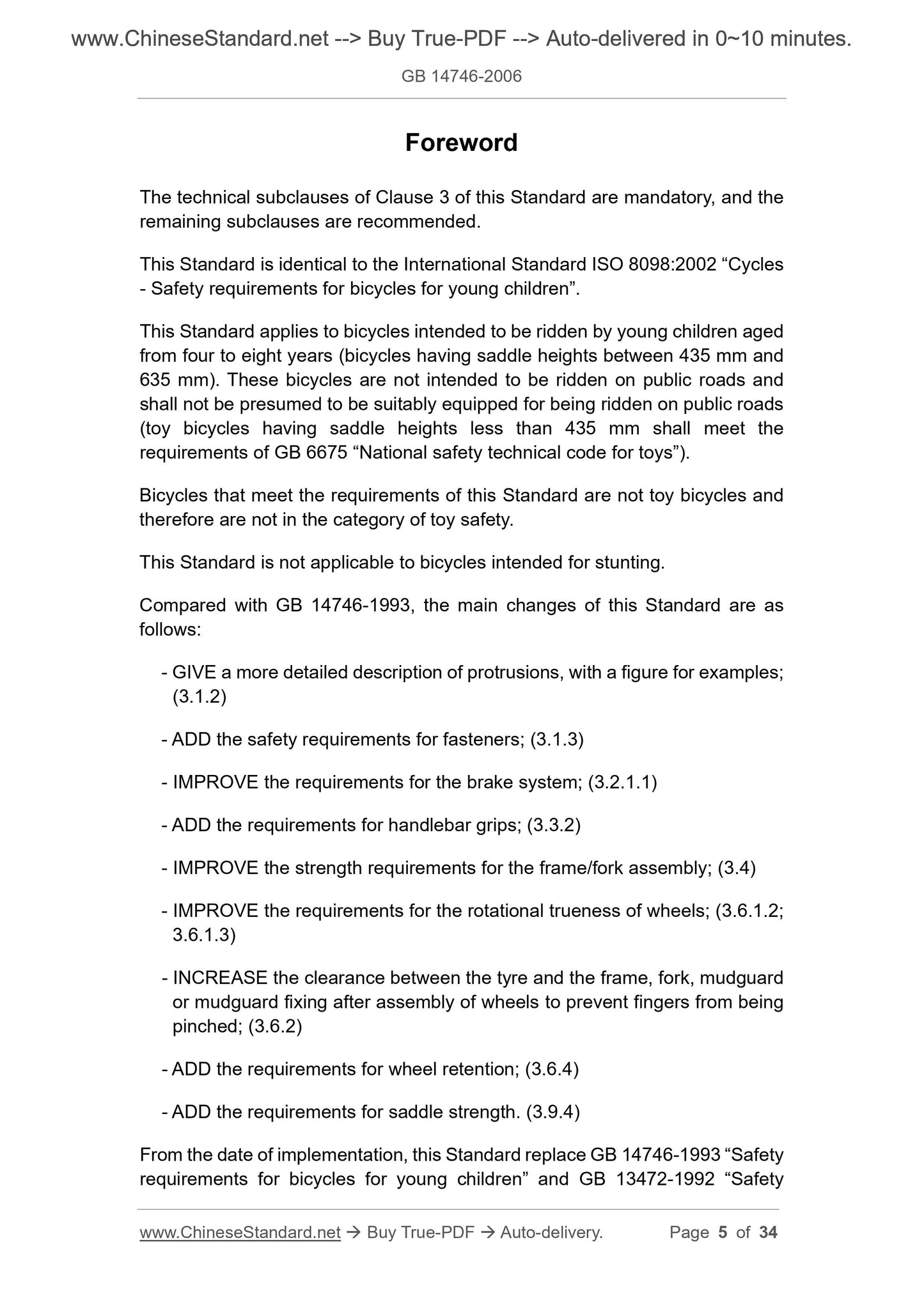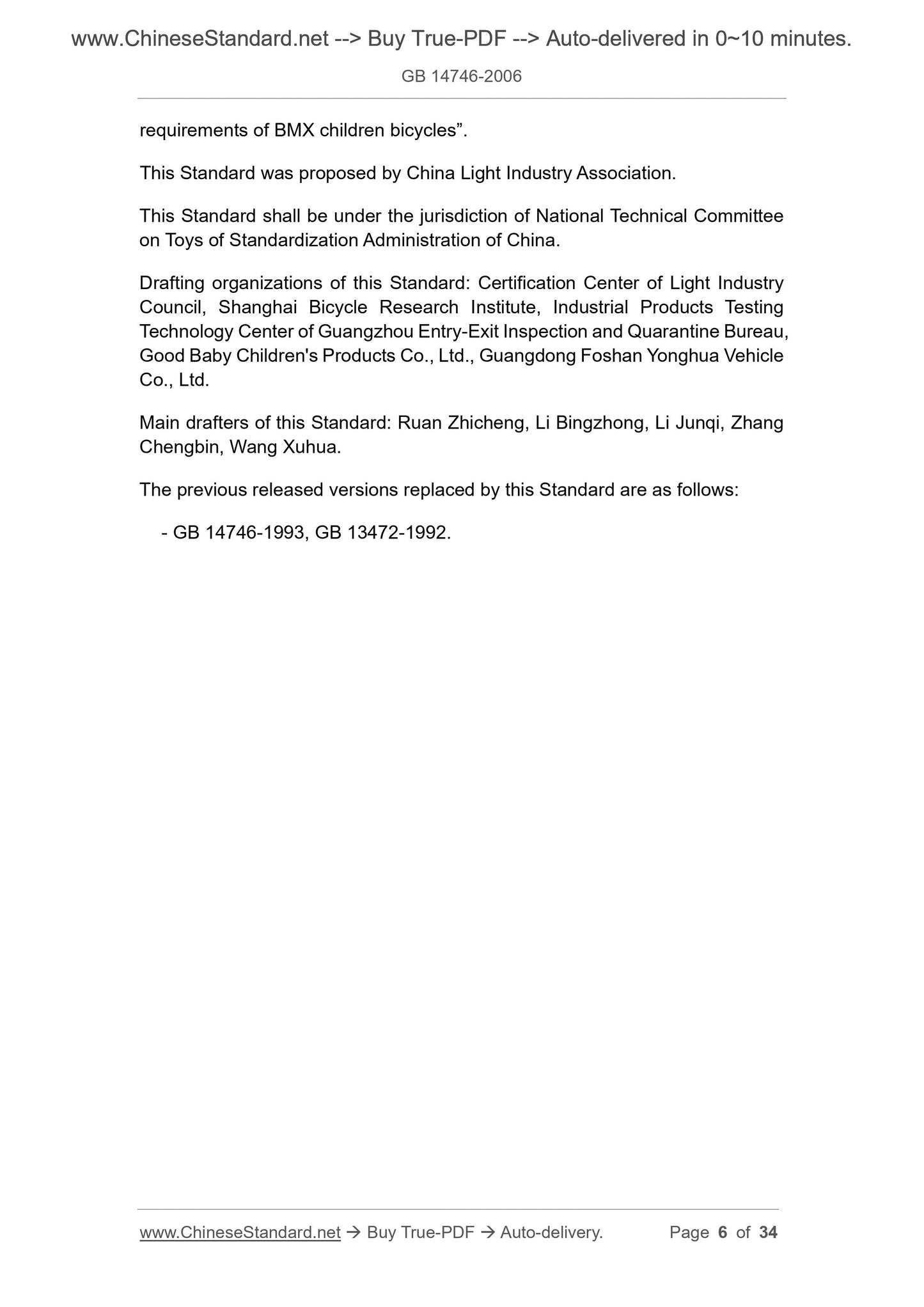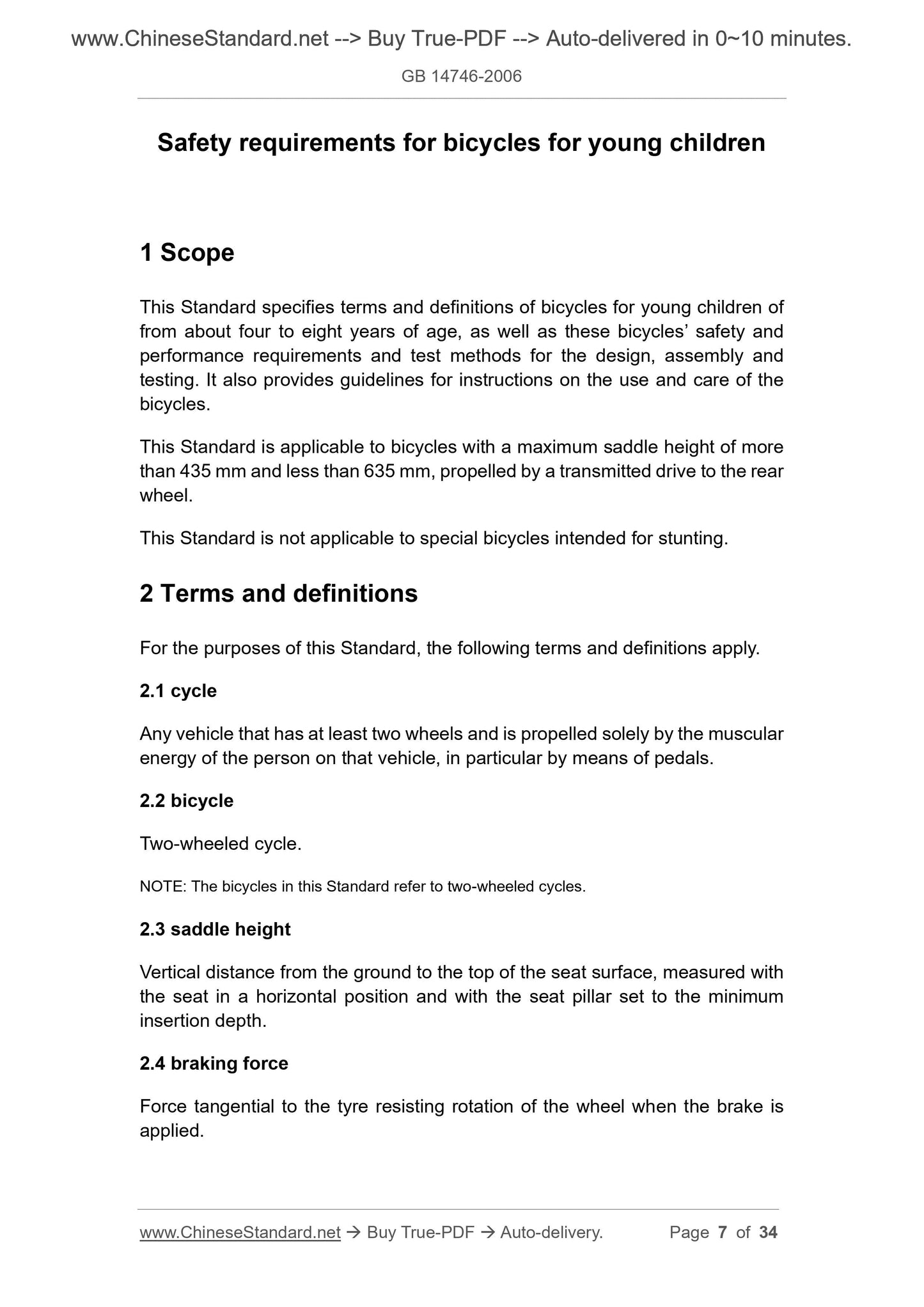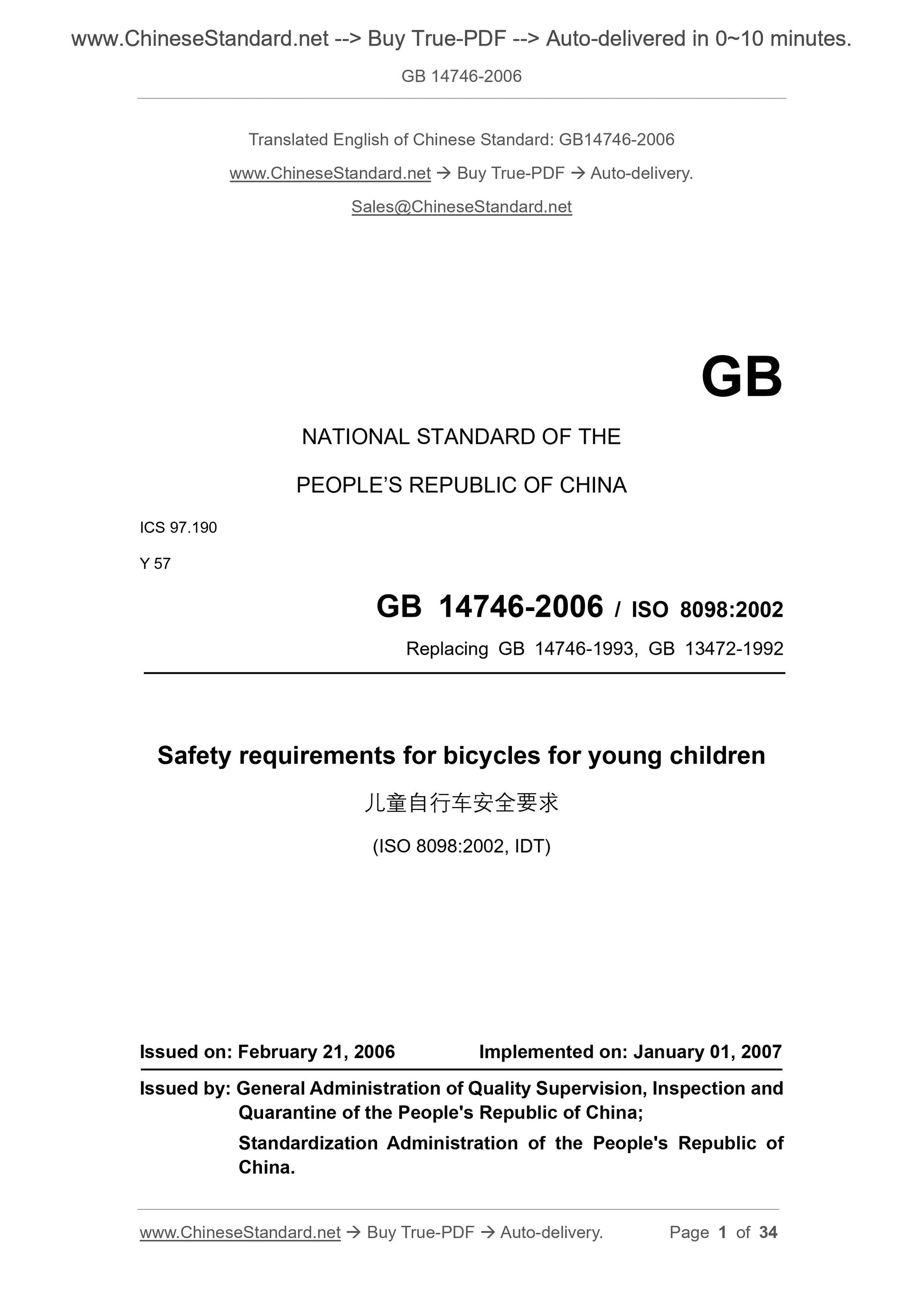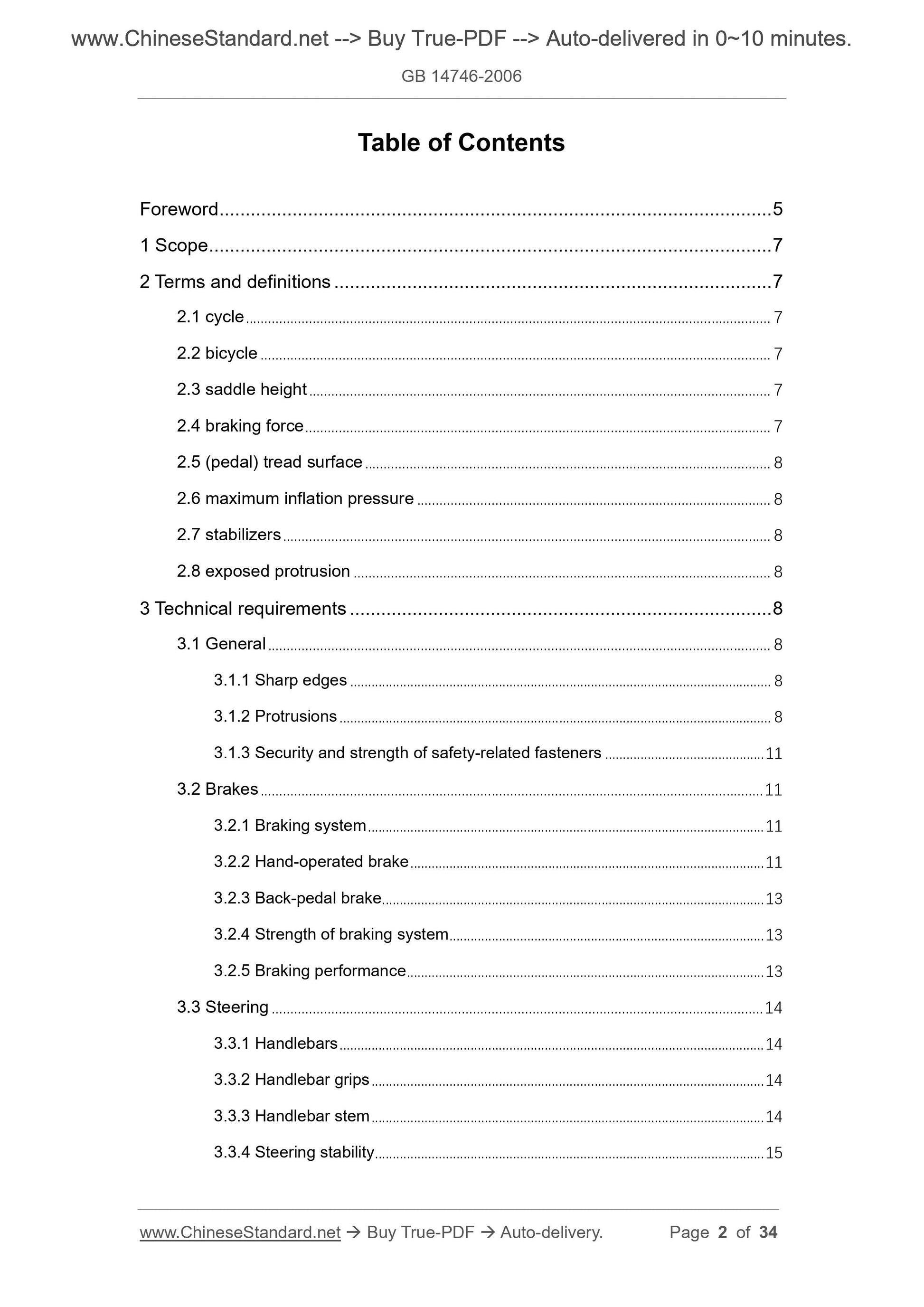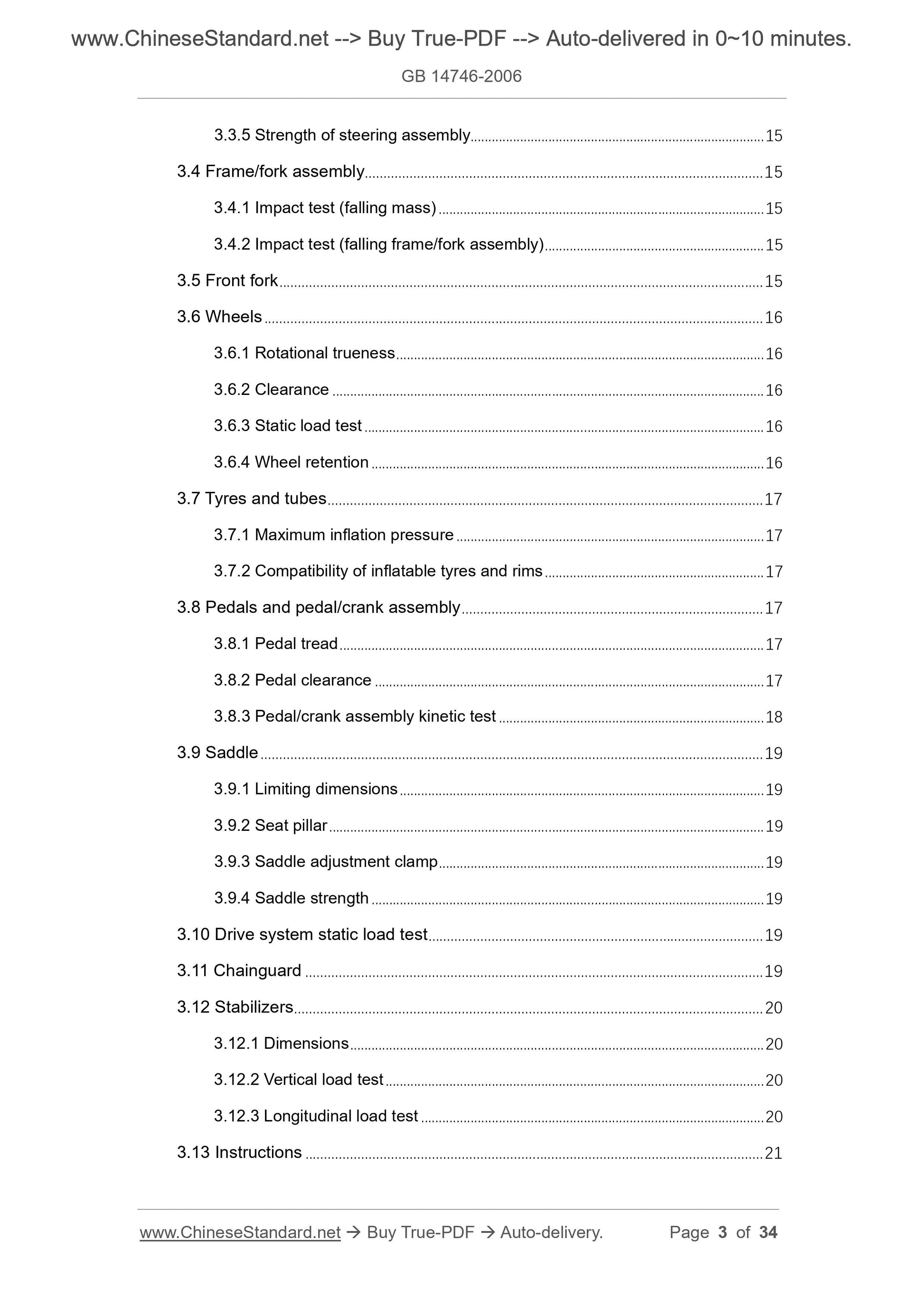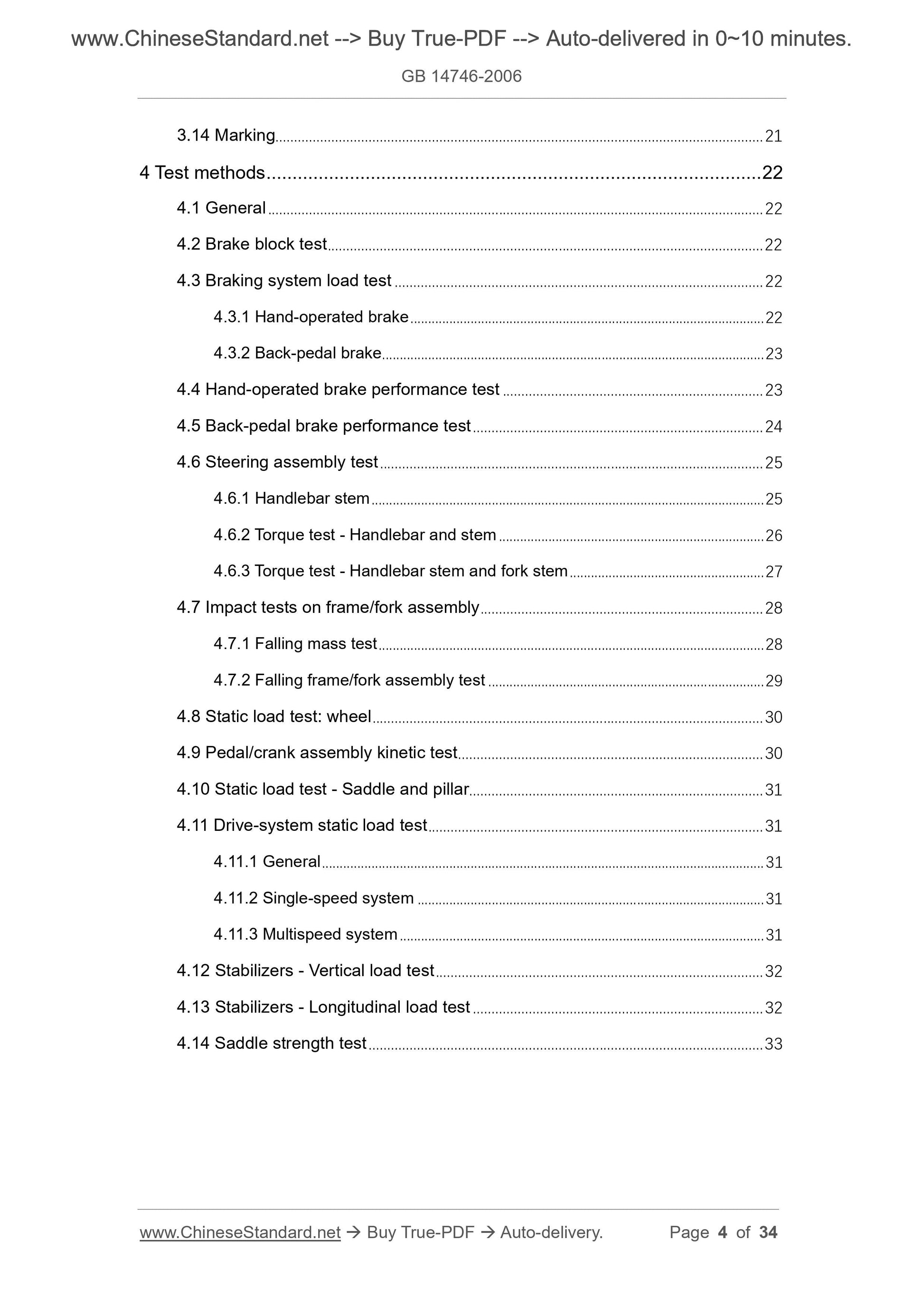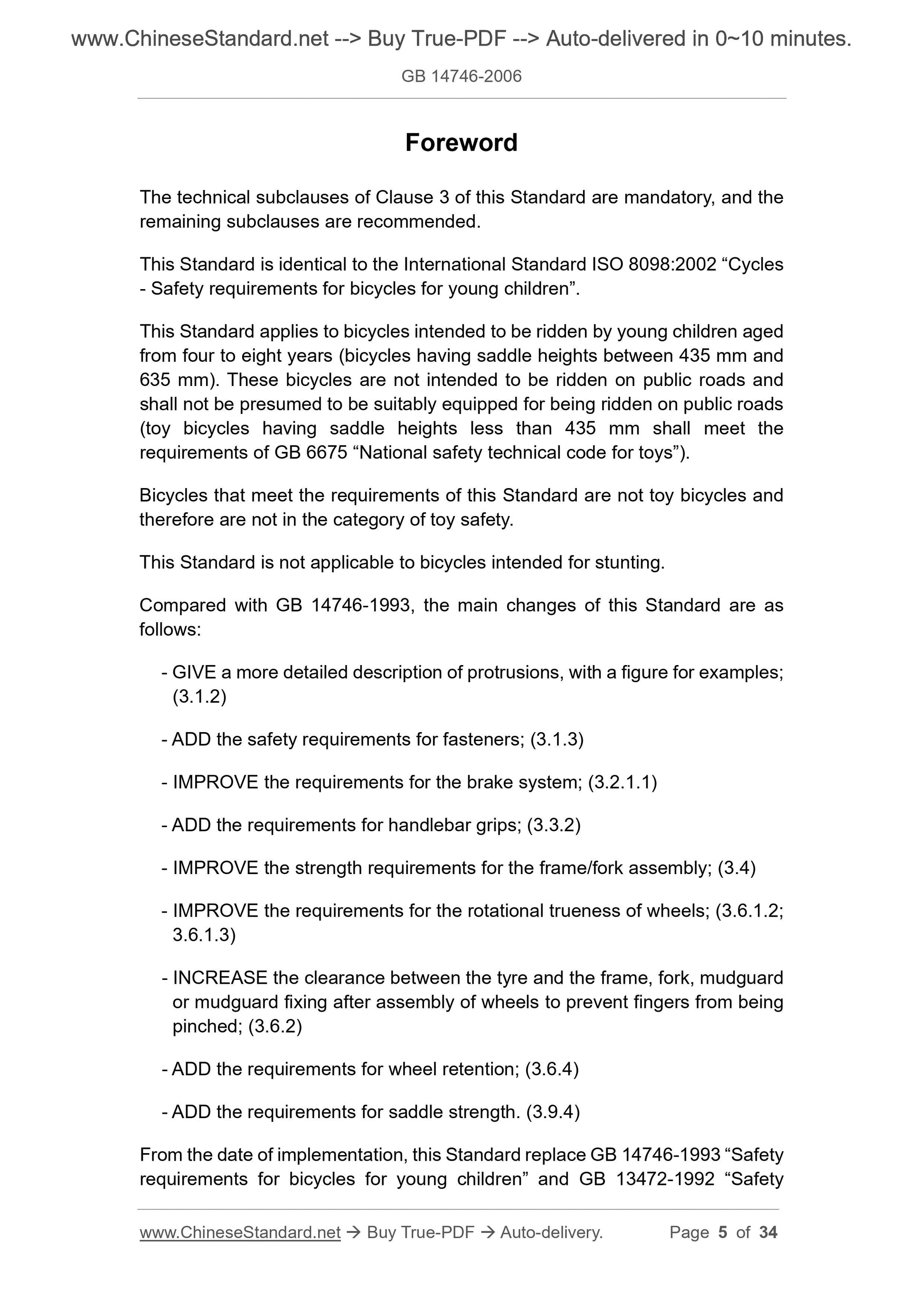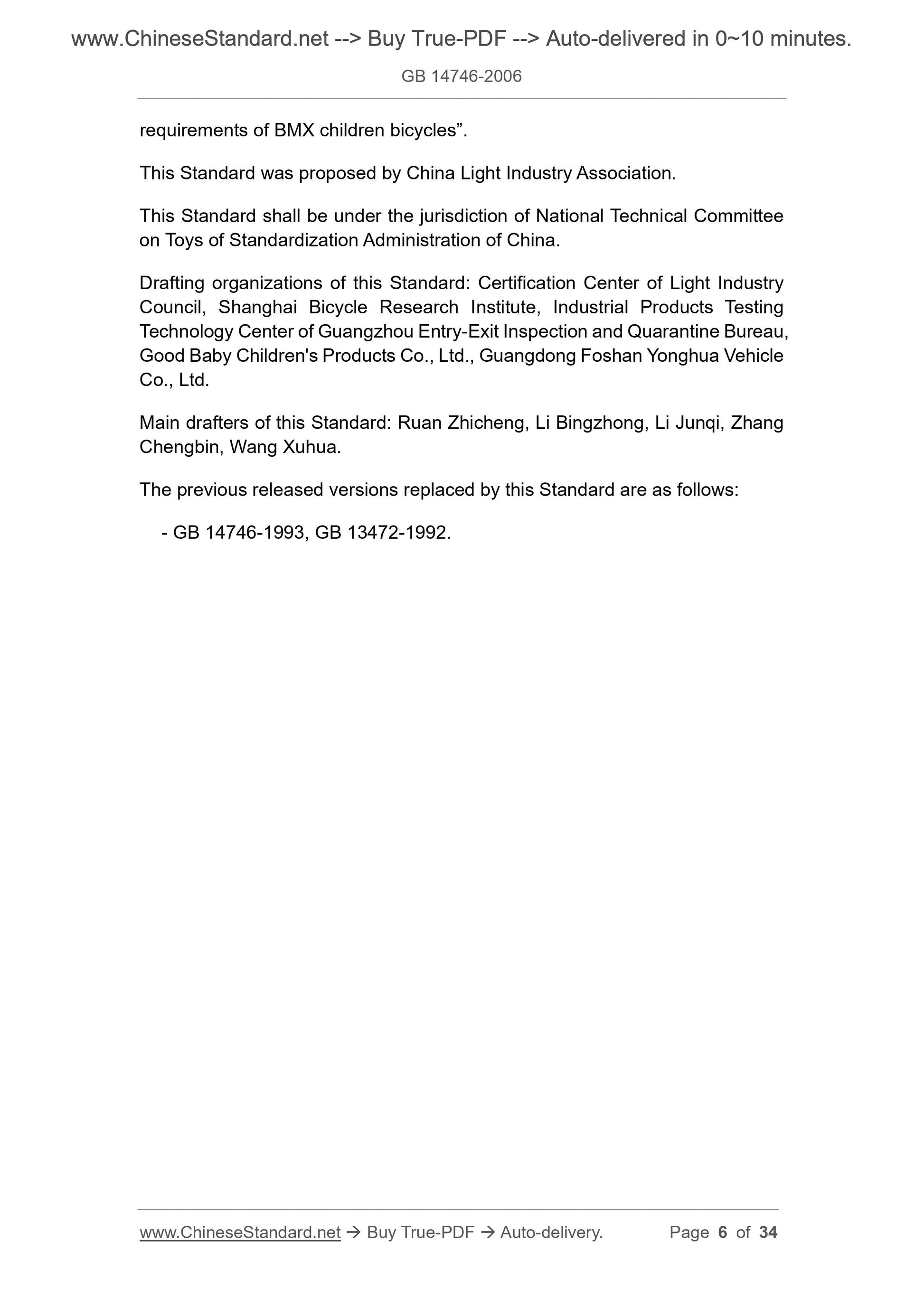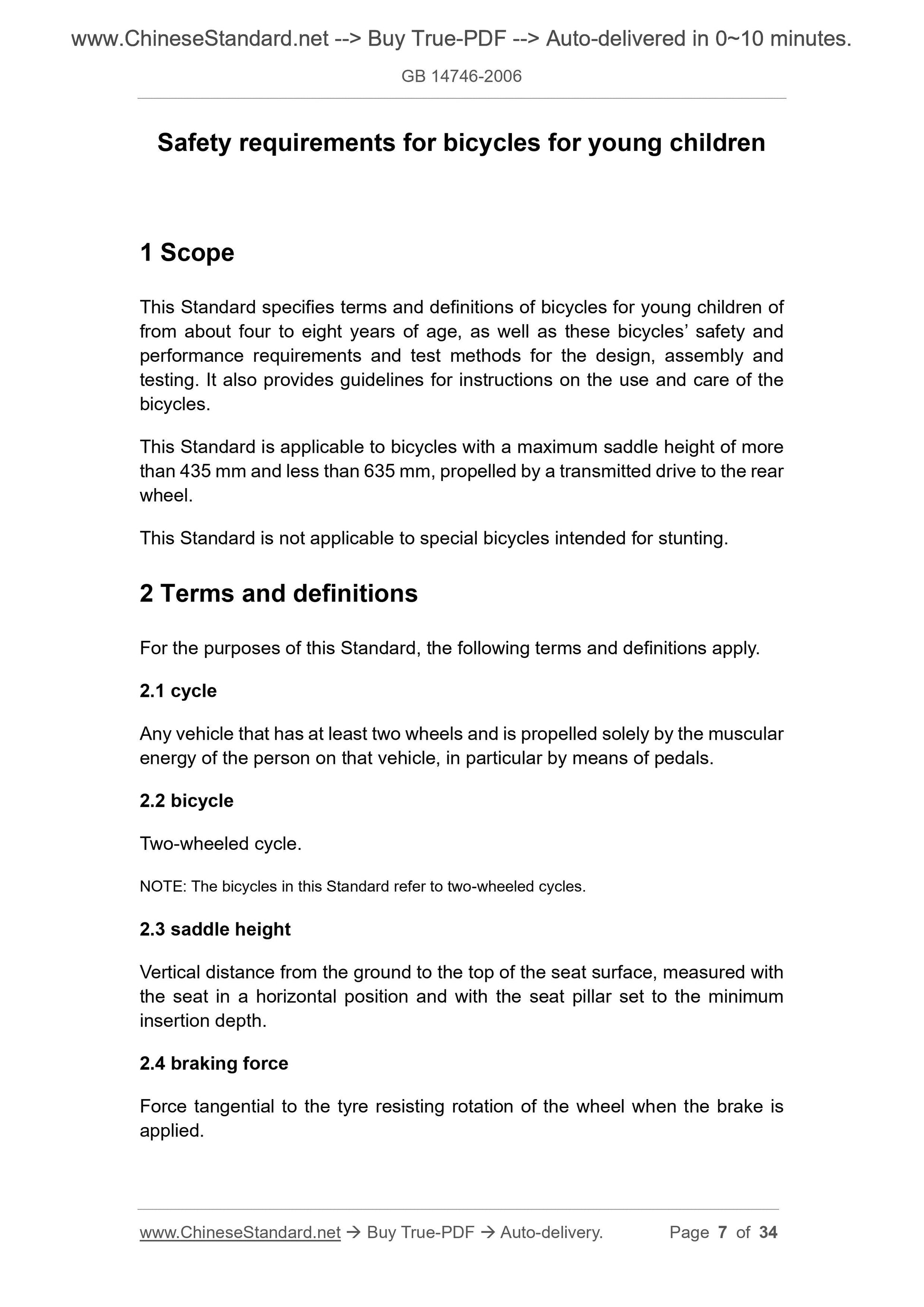1
/
su
7
PayPal, credit cards. Download editable-PDF and invoice in 1 second!
GB 14746-2006 English PDF (GB14746-2006)
GB 14746-2006 English PDF (GB14746-2006)
Prezzo di listino
$145.00 USD
Prezzo di listino
Prezzo scontato
$145.00 USD
Prezzo unitario
/
per
Spese di spedizione calcolate al check-out.
Impossibile caricare la disponibilità di ritiro
Delivery: 3 seconds. Download true-PDF + Invoice.
Get QUOTATION in 1-minute: Click GB 14746-2006
Historical versions: GB 14746-2006
Preview True-PDF (Reload/Scroll if blank)
GB 14746-2006: Safety requirements for bicycles for young children
GB 14746-2006
GB
NATIONAL STANDARD OF THE
PEOPLE’S REPUBLIC OF CHINA
ICS 97.190
Y 57
GB 14746-2006 / ISO 8098.2002
Replacing GB 14746-1993, GB 13472-1992
Safety requirements for bicycles for young children
(ISO 8098.2002, IDT)
ISSUED ON. FEBRUARY 21, 2006
IMPLEMENTED ON. JANUARY 01, 2007
Issued by. General Administration of Quality Supervision, Inspection and
Quarantine of the People's Republic of China;
Standardization Administration of the People's Republic of
China.
Table of Contents
Foreword ... 5
1 Scope ... 7
2 Terms and definitions ... 7
2.1 cycle ... 7
2.2 bicycle ... 7
2.3 saddle height ... 7
2.4 braking force ... 7
2.5 (pedal) tread surface ... 8
2.6 maximum inflation pressure ... 8
2.7 stabilizers ... 8
2.8 exposed protrusion ... 8
3 Technical requirements ... 8
3.1 General ... 8
3.1.1 Sharp edges ... 8
3.1.2 Protrusions ... 8
3.1.3 Security and strength of safety-related fasteners ... 11
3.2 Brakes ... 11
3.2.1 Braking system ... 11
3.2.2 Hand-operated brake ... 11
3.2.3 Back-pedal brake ... 13
3.2.4 Strength of braking system ... 13
3.2.5 Braking performance ... 13
3.3 Steering ... 14
3.3.1 Handlebars ... 14
3.3.2 Handlebar grips ... 14
3.3.3 Handlebar stem ... 14
3.3.4 Steering stability ... 15
3.3.5 Strength of steering assembly ... 15
3.4 Frame/fork assembly ... 15
3.4.1 Impact test (falling mass) ... 15
3.4.2 Impact test (falling frame/fork assembly) ... 15
3.5 Front fork ... 15
3.6 Wheels ... 16
3.6.1 Rotational trueness ... 16
3.6.2 Clearance ... 16
3.6.3 Static load test ... 16
3.6.4 Wheel retention ... 16
3.7 Tyres and tubes ... 17
3.7.1 Maximum inflation pressure ... 17
3.7.2 Compatibility of inflatable tyres and rims ... 17
3.8 Pedals and pedal/crank assembly ... 17
3.8.1 Pedal tread ... 17
3.8.2 Pedal clearance ... 17
3.8.3 Pedal/crank assembly kinetic test ... 18
3.9 Saddle ... 19
3.9.1 Limiting dimensions ... 19
3.9.2 Seat pillar ... 19
3.9.3 Saddle adjustment clamp ... 19
3.9.4 Saddle strength ... 19
3.10 Drive system static load test ... 19
3.11 Chainguard ... 19
3.12 Stabilizers ... 20
3.12.1 Dimensions ... 20
3.12.2 Vertical load test ... 20
3.12.3 Longitudinal load test ... 20
3.13 Instructions ... 21
3.14 Marking... 21
4 Test methods ... 22
4.1 General ... 22
4.2 Brake block test ... 22
4.3 Braking system load test ... 22
4.3.1 Hand-operated brake ... 22
4.3.2 Back-pedal brake ... 23
4.4 Hand-operated brake performance test ... 23
4.5 Back-pedal brake performance test ... 24
4.6 Steering assembly test ... 25
4.6.1 Handlebar stem ... 25
4.6.2 Torque test - Handlebar and stem ... 26
4.6.3 Torque test - Handlebar stem and fork stem ... 27
4.7 Impact tests on frame/fork assembly ... 28
4.7.1 Falling mass test ... 28
4.7.2 Falling frame/fork assembly test ... 29
4.8 Static load test. wheel ... 30
4.9 Pedal/crank assembly kinetic test ... 30
4.10 Static load test - Saddle and pillar ... 31
4.11 Drive-system static load test ... 31
4.11.1 General ... 31
4.11.2 Single-speed system ... 31
4.11.3 Multispeed system ... 31
4.12 Stabilizers - Vertical load test ... 32
4.13 Stabilizers - Longitudinal load test ... 32
4.14 Saddle strength test ... 33
Foreword
The technical subclauses of Clause 3 of this Standard are mandatory, and the
remaining subclauses are recommended.
This Standard is identical to the International Standard ISO 8098.2002 “Cycles
- Safety requirements for bicycles for young children”.
This Standard applies to bicycles intended to be ridden by young children aged
from four to eight years (bicycles having saddle heights between 435 mm and
635 mm). These bicycles are not intended to be ridden on public roads and
shall not be presumed to be suitably equipped for being ridden on public roads
(toy bicycles having saddle heights less than 435 mm shall meet the
requirements of GB 6675 “National safety technical code for toys”).
Bicycles that meet the requirements of this Standard are not toy bicycles and
therefore are not in the category of toy safety.
This Standard is not applicable to bicycles intended for stunting.
Compared with GB 14746-1993, the main changes of this Standard are as
follows.
- GIVE a more detailed description of protrusions, with a figure for examples;
(3.1.2)
- ADD the safety requirements for fasteners; (3.1.3)
- IMPROVE the requirements for the brake system; (3.2.1.1)
- ADD the requirements for handlebar grips; (3.3.2)
- IMPROVE the strength requirements for the frame/fork assembly; (3.4)
- IMPROVE the requirements for the rotational trueness of wheels; (3.6.1.2;
3.6.1.3)
- INCREASE the clearance between the tyre and the frame, fork, mudguard
or mudguard fixing after assembly of wheels to prevent fingers from being
pinched; (3.6.2)
- ADD the requirements for wheel retention; (3.6.4)
- ADD the requirements for saddle strength. (3.9.4)
From the date of implementation, this Standard replace GB 14746-1993 “Safety
requirements for bicycles for young children” and GB 13472-1992 “Safety
requirements of BMX children bicycles”.
This Standard was proposed by China Light Industry Association.
This Standard shall be under the jurisdiction of National Technical Committee
on Toys of Standardization Administration of China.
Drafting organizations of this Standard. Certification Center of Light Industry
Council, Shanghai Bicycle Research Institute, Industrial Products Testing
Technology Center of Guangzhou Entry-Exit Inspection and Quarantine Bureau,
Good Baby Children's Products Co., Ltd., Guangdong Foshan Yonghua Vehicle
Co., Ltd.
Main drafters of this Standard. Ruan Zhicheng, Li Bingzhong, Li Junqi, Zhang
Chengbin, Wang Xuhua.
The previous released versions replaced by this Standard are as follows.
- GB 14746-1993, GB 13472-1992.
Safety requirements for bicycles for young children
1 Scope
This Standard specifies terms and definitions of bicycles for young children of
from about four to eight years of age, as well as these bicycles’ safety and
performance requirements and test methods for the design, assembly and
testing. It also provides guidelines for instructions on the use and care of the
bicycles.
This Standard is applicable to bicycles with a maximum saddle height of more
than 435 mm and less than 635 mm, propelled by a transmitted drive to the rear
wheel.
This Standard is not applicable to special bicycles intended for stunting.
2 Terms and definitions
For the purposes of this Standard, the following terms and definitions apply.
2.1 cycle
Any vehicle that has at least two wheels and is propelled solely by the muscular
energy of the person on that vehicle, in particular by means of pedals.
2.2 bicycle
Two-wheeled cycle.
NOTE. The bicycles in this Standard refer to two-wheeled cycles.
2.3 saddle height
Vertical distance from the ground to the top of the seat surface, measured with
the seat in a horizontal position and with the seat pillar set to the minimum
insertion depth.
2.4 braking force
Force tangential to the tyre resisting rotation of the wheel when the brake is
applied.
Get QUOTATION in 1-minute: Click GB 14746-2006
Historical versions: GB 14746-2006
Preview True-PDF (Reload/Scroll if blank)
GB 14746-2006: Safety requirements for bicycles for young children
GB 14746-2006
GB
NATIONAL STANDARD OF THE
PEOPLE’S REPUBLIC OF CHINA
ICS 97.190
Y 57
GB 14746-2006 / ISO 8098.2002
Replacing GB 14746-1993, GB 13472-1992
Safety requirements for bicycles for young children
(ISO 8098.2002, IDT)
ISSUED ON. FEBRUARY 21, 2006
IMPLEMENTED ON. JANUARY 01, 2007
Issued by. General Administration of Quality Supervision, Inspection and
Quarantine of the People's Republic of China;
Standardization Administration of the People's Republic of
China.
Table of Contents
Foreword ... 5
1 Scope ... 7
2 Terms and definitions ... 7
2.1 cycle ... 7
2.2 bicycle ... 7
2.3 saddle height ... 7
2.4 braking force ... 7
2.5 (pedal) tread surface ... 8
2.6 maximum inflation pressure ... 8
2.7 stabilizers ... 8
2.8 exposed protrusion ... 8
3 Technical requirements ... 8
3.1 General ... 8
3.1.1 Sharp edges ... 8
3.1.2 Protrusions ... 8
3.1.3 Security and strength of safety-related fasteners ... 11
3.2 Brakes ... 11
3.2.1 Braking system ... 11
3.2.2 Hand-operated brake ... 11
3.2.3 Back-pedal brake ... 13
3.2.4 Strength of braking system ... 13
3.2.5 Braking performance ... 13
3.3 Steering ... 14
3.3.1 Handlebars ... 14
3.3.2 Handlebar grips ... 14
3.3.3 Handlebar stem ... 14
3.3.4 Steering stability ... 15
3.3.5 Strength of steering assembly ... 15
3.4 Frame/fork assembly ... 15
3.4.1 Impact test (falling mass) ... 15
3.4.2 Impact test (falling frame/fork assembly) ... 15
3.5 Front fork ... 15
3.6 Wheels ... 16
3.6.1 Rotational trueness ... 16
3.6.2 Clearance ... 16
3.6.3 Static load test ... 16
3.6.4 Wheel retention ... 16
3.7 Tyres and tubes ... 17
3.7.1 Maximum inflation pressure ... 17
3.7.2 Compatibility of inflatable tyres and rims ... 17
3.8 Pedals and pedal/crank assembly ... 17
3.8.1 Pedal tread ... 17
3.8.2 Pedal clearance ... 17
3.8.3 Pedal/crank assembly kinetic test ... 18
3.9 Saddle ... 19
3.9.1 Limiting dimensions ... 19
3.9.2 Seat pillar ... 19
3.9.3 Saddle adjustment clamp ... 19
3.9.4 Saddle strength ... 19
3.10 Drive system static load test ... 19
3.11 Chainguard ... 19
3.12 Stabilizers ... 20
3.12.1 Dimensions ... 20
3.12.2 Vertical load test ... 20
3.12.3 Longitudinal load test ... 20
3.13 Instructions ... 21
3.14 Marking... 21
4 Test methods ... 22
4.1 General ... 22
4.2 Brake block test ... 22
4.3 Braking system load test ... 22
4.3.1 Hand-operated brake ... 22
4.3.2 Back-pedal brake ... 23
4.4 Hand-operated brake performance test ... 23
4.5 Back-pedal brake performance test ... 24
4.6 Steering assembly test ... 25
4.6.1 Handlebar stem ... 25
4.6.2 Torque test - Handlebar and stem ... 26
4.6.3 Torque test - Handlebar stem and fork stem ... 27
4.7 Impact tests on frame/fork assembly ... 28
4.7.1 Falling mass test ... 28
4.7.2 Falling frame/fork assembly test ... 29
4.8 Static load test. wheel ... 30
4.9 Pedal/crank assembly kinetic test ... 30
4.10 Static load test - Saddle and pillar ... 31
4.11 Drive-system static load test ... 31
4.11.1 General ... 31
4.11.2 Single-speed system ... 31
4.11.3 Multispeed system ... 31
4.12 Stabilizers - Vertical load test ... 32
4.13 Stabilizers - Longitudinal load test ... 32
4.14 Saddle strength test ... 33
Foreword
The technical subclauses of Clause 3 of this Standard are mandatory, and the
remaining subclauses are recommended.
This Standard is identical to the International Standard ISO 8098.2002 “Cycles
- Safety requirements for bicycles for young children”.
This Standard applies to bicycles intended to be ridden by young children aged
from four to eight years (bicycles having saddle heights between 435 mm and
635 mm). These bicycles are not intended to be ridden on public roads and
shall not be presumed to be suitably equipped for being ridden on public roads
(toy bicycles having saddle heights less than 435 mm shall meet the
requirements of GB 6675 “National safety technical code for toys”).
Bicycles that meet the requirements of this Standard are not toy bicycles and
therefore are not in the category of toy safety.
This Standard is not applicable to bicycles intended for stunting.
Compared with GB 14746-1993, the main changes of this Standard are as
follows.
- GIVE a more detailed description of protrusions, with a figure for examples;
(3.1.2)
- ADD the safety requirements for fasteners; (3.1.3)
- IMPROVE the requirements for the brake system; (3.2.1.1)
- ADD the requirements for handlebar grips; (3.3.2)
- IMPROVE the strength requirements for the frame/fork assembly; (3.4)
- IMPROVE the requirements for the rotational trueness of wheels; (3.6.1.2;
3.6.1.3)
- INCREASE the clearance between the tyre and the frame, fork, mudguard
or mudguard fixing after assembly of wheels to prevent fingers from being
pinched; (3.6.2)
- ADD the requirements for wheel retention; (3.6.4)
- ADD the requirements for saddle strength. (3.9.4)
From the date of implementation, this Standard replace GB 14746-1993 “Safety
requirements for bicycles for young children” and GB 13472-1992 “Safety
requirements of BMX children bicycles”.
This Standard was proposed by China Light Industry Association.
This Standard shall be under the jurisdiction of National Technical Committee
on Toys of Standardization Administration of China.
Drafting organizations of this Standard. Certification Center of Light Industry
Council, Shanghai Bicycle Research Institute, Industrial Products Testing
Technology Center of Guangzhou Entry-Exit Inspection and Quarantine Bureau,
Good Baby Children's Products Co., Ltd., Guangdong Foshan Yonghua Vehicle
Co., Ltd.
Main drafters of this Standard. Ruan Zhicheng, Li Bingzhong, Li Junqi, Zhang
Chengbin, Wang Xuhua.
The previous released versions replaced by this Standard are as follows.
- GB 14746-1993, GB 13472-1992.
Safety requirements for bicycles for young children
1 Scope
This Standard specifies terms and definitions of bicycles for young children of
from about four to eight years of age, as well as these bicycles’ safety and
performance requirements and test methods for the design, assembly and
testing. It also provides guidelines for instructions on the use and care of the
bicycles.
This Standard is applicable to bicycles with a maximum saddle height of more
than 435 mm and less than 635 mm, propelled by a transmitted drive to the rear
wheel.
This Standard is not applicable to special bicycles intended for stunting.
2 Terms and definitions
For the purposes of this Standard, the following terms and definitions apply.
2.1 cycle
Any vehicle that has at least two wheels and is propelled solely by the muscular
energy of the person on that vehicle, in particular by means of pedals.
2.2 bicycle
Two-wheeled cycle.
NOTE. The bicycles in this Standard refer to two-wheeled cycles.
2.3 saddle height
Vertical distance from the ground to the top of the seat surface, measured with
the seat in a horizontal position and with the seat pillar set to the minimum
insertion depth.
2.4 braking force
Force tangential to the tyre resisting rotation of the wheel when the brake is
applied.
Share
